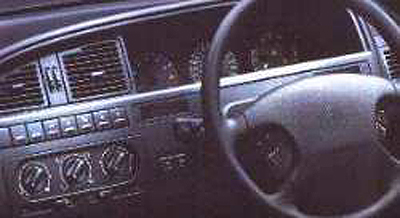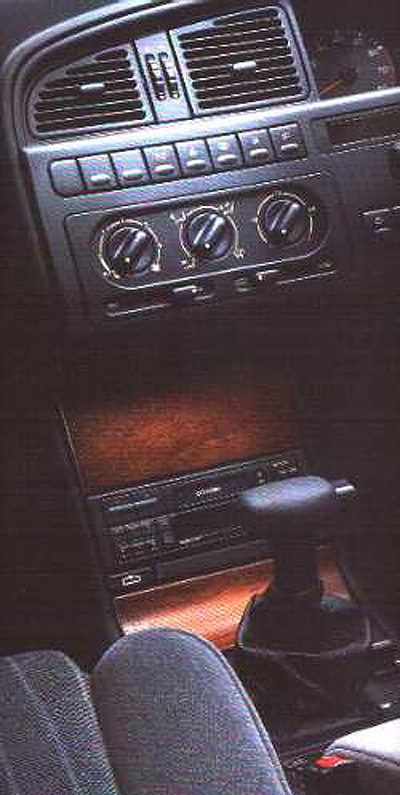|
First
impressions,
from the outside, are of a big car and
these impressions are reinforced when you
climb inside. The base of the windscreen
seems a long way away, there is plenty of
legroom and elbow room and in common with
its CX and DS predecessors, the
extremities of the car are invisible from
the driving seat. That long bonnet is
invisible and the impression is almost one
of driving a forward control vehicle.
 The
seats
are bulky, comfortable and supportive with
electric adjustment of fore and aft
position, height and seat back angle. The
steering column too is adjustable for rake
and reach but despite this, I find that
the steering wheel rim obscures the tacho
between 2 000 and 4 000 rpm - I am six
feet tall (1 m 84) so hardly outside the
likely size range of prospective drivers.
The
seats
are bulky, comfortable and supportive with
electric adjustment of fore and aft
position, height and seat back angle. The
steering column too is adjustable for rake
and reach but despite this, I find that
the steering wheel rim obscures the tacho
between 2 000 and 4 000 rpm - I am six
feet tall (1 m 84) so hardly outside the
likely size range of prospective drivers.
Mounted
in
front of the steering wheel are three
display panels - the left hand one is used
to display warnings such as doors open,
radio station, tape or CD player
indicators, selection of sports or normal
suspension and defective lamps. The middle
display panel shows the following:-
|
Engine
coolant
temperature pre-warning
Engine
coolant temperature
Parking
brake
Hydraulic
pressure and level
Low
level screen wash
|
Front
brake
pad wear
Battery
charge
Engine
oil pressure Engine oil
temperature Coolant level Engine
auto diagnosis
|
|
 |
|
The
right
hand panel comprises the clock and can
display five additional types of
information:- ambient temperature,
instantaneous fuel consumption, average
fuel consumption, average speed and
remaining range.
There
are
two conventional stalks mounted either
side of the steering wheel - the left one
controls the horn, indicators, headlamp
main/dip and flash and lights on/off while
the right one is responsible for wipers,
washers and selection of ambient
temperature, instantaneous fuel
consumption, average fuel consumption,
average speed and remaining range
functions.
Below
the
central air vents are switches for front
fog lamps, rear fog lamps, rear screen
demister, hazard warning lamps, interior
lights and burglar alarm.
To
the
left of the steering column are two
further switches for the rear screen wiper
and rear screen washer while on the right
there is a rheostat for controlling the
brightness of the instrument panel
lighting.
The
centre
console has the controls for heating and
ventilation, a veneered flap covering a
small stowage space, the stereo and the
ash tray which is also covered by a
veneered flap
|
The
auto
transmission selector is conventionally
placed on the floor but on either side of
it are controls you won't see on anything
but an hydropneumatic CitroŽn.
On
the left is a switch allowing you to
select normal or sports suspension
settings while to the right is a control
that enables the ground clearance to be
varied.
What
is
missing however is the parking brake -
this is operated by a pedal to the left of
the footbrake with a release/lock lever to
the right of the steering column - even on
cars fitted with a manual gearbox.
To
start
the engine, you must first enter a
security code on a keypad located aft of
the gear selector. Unlike hydropneumatic
CitroŽns of old, you don't have to wait
for the car to rise up to normal ride
height - a valve in the suspension
stops the car from settling onto its bump
stops overnight (although after a
prolonged hiatus it will sink to its
haunches).
|